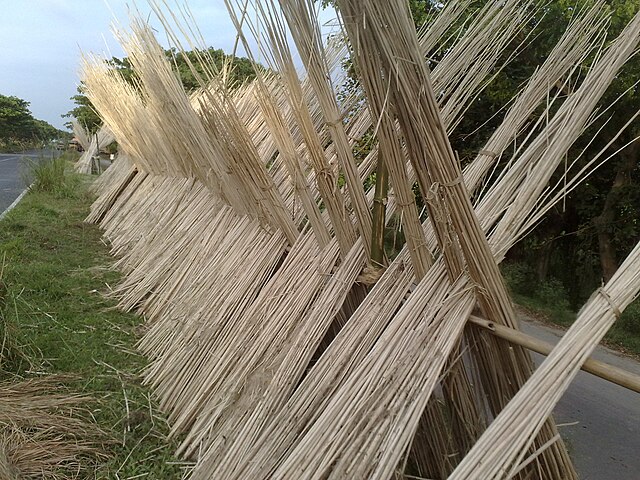黄麻(拉丁语:Corchorus)是一种长而柔软的、发出光泽的植物纤维,可以织成高强度的粗糙的细丝。它在植物分类上属于椴树亚科的黄麻属。
黄麻是最廉价的天然纤维之一,种植量和用途的广泛都仅次于棉花。 它和洋麻、大麻、亚麻、苎麻等同样属于韧皮纤维(从植物内皮或外皮提取的纤维)。纤维的颜色从白色到褐色,长1–4 米。

耕种栽培
适合种植黄麻的气候为在盛行季风季节的季风气候(温暖,潮湿的气候)。适宜的气温为20˚C至40˚C和相对湿度70%-80%。 :黄麻在播种期间需要比其他时期多5-8厘米/周的降雨。
品种
圆果黄麻(学名:Corchorus capsularis),在中国称作白黄麻。在几个历史记录中指出,贫穷的印度村民穿用黄麻制成的衣服。用简单的手摇纺织机和手纺车进行织布,将黄麻当成纺棉纱使用。历史上还指出,孟加拉人从更早的时代,就把家庭和其他用途的白黄麻制成的绳索和细绳。
长蒴黄麻(学名:Corchorus olitorius) ,在中国称作红麻,是非洲 - 阿拉伯的品种和锦葵科的成员(跟棉花同一科)。他也是很受欢迎的叶用蔬菜,阿拉伯人称为“molokhiya”([ملوخية]=“国王”的意思),其叶为成分跟秋葵黏滑的成分相似。 犹太人在约伯记提到长果黄麻也是一种称作棣棠花(Jew's mallow)的蔬菜。
长果黄麻纤维比圆果黄麻更柔软、柔滑。也发现很适合在恒河三角洲气候栽种。19世纪时,随着圆果黄麻栽种,长果黄麻也开始在孟加拉栽培。目前,孟加拉地区(巴基斯坦、印度和孟加拉)是长果黄麻的世界最大的生产地区。
用途

黄麻是重要性仅次于棉花的植物纤维;拥有多种用途。首先是用于原棉打包的包装运输袋,其次是制成袋子或粗布,还可以织成窗帘、椅套、地毯、粗麻布和油布的衬背,更可以当作造纸原料。黄麻杆也可当作燃料、活性碳、纤维版等,可以取代伐木工业的部分性质。
特征
- 黄麻纤维可以100%进行生物分解和回收,对环境无害。
- 它是一种拥有黄金和丝绸光泽的天然纤维,因而被称为“金色纤维”。
- 它是最便宜的植物纤维,取自植物的茎的内皮或外皮。
- 它在使用、全球消费量、生产和实用方面的重要性仅次于棉花的植物纤维。
- 它的抗张强度很高,延展性低,防水性能较好。因此,黄麻非常适合于大批量农产品的包装。
注释
参考
- Basu, G., A. K. Sinha, and S. N. Chattopadhyay. "Properties of Jute Based Ternary Blended Bulked Yarns". Man-Made Textiles in India. Vol. 48, no. 9 (Sep. 2005): 350–353. (AN 18605324)
- Chattopadhyay, S. N., N. C. Pan, and A. Day. "A Novel Process of Dyeing of Jute Fabric Using Reactive Dye". Textile Industry of India. Vol. 42, no. 9 (Sep. 2004): 15–22. (AN 17093709)
- Doraiswamy, I., A. Basu, and K. P. Chellamani. "Development of Fine Quality Jute Fibres". Colourage. Nov. 6–8, 1998, 2p. (AN TDH0624047199903296)
- Kozlowski, R., and S. Manys. "Green Fibres". Textile Industry: Winning Strategies for the New Millennium—Papers Presented at the World Conference. Feb. 10–13, 1999: 29 (13p). (AN TDH0646343200106392)
- Madhu, T. "Bio-Composites—An Overview". Textile Magazine. Vol. 43, no. 8 (Jun. 2002): 49 (2 pp). (AN TDH0656367200206816)
- Maulik, S. R. "Chemical Modification of Jute". Asian Textile Journal. Vol. 10, no. 7 (Jul. 2001): 99 (8 pp). (AN TDH0648424200108473)
- Moses, J. Jeyakodi, and M. Ramasamy. "Quality Improvement on Jute and Jute Cotton Materials Using Enzyme Treatment and Natural Dyeing". Man-Made Textiles in India. Vol. 47, no. 7 (Jul. 2004): 252–255. (AN 14075527)
- Pan, N. C., S. N. Chattopadhyay, and A. Day. "Dyeing of Jute Fabric with Natural Dye Extracted from Marigold Flower". Asian Textile Journal. Vol. 13, no. 7 (Jul. 2004): 80–82. (AN 15081016)
- Pan, N. C., A. Day, and K. K. Mahalanabis. "Properties of Jute". Indian Textile Journal. Vol. 110, no. 5 (Feb. 2000): 16. (AN TDH0635236200004885)
- Roy, T. K. G., S. K. Chatterjee, and B. D. Gupta. "Comparative Studies on Bleaching and Dyeing of Jute after Processing with Mineral Oil in Water Emulsion vis-a-vis Self-Emulsifiable Castor Oil". Colourage. Vol. 49, no. 8 (Aug. 2002): 27 (5 pp). (AN TDH0657901200208350)
- Shenai, V. A. "Enzyme Treatment". Indian Textile Journal. Vol. 114, no. 2 (Nov. 2003): 112–113. (AN 13153355)
- Srinivasan, J., A. Venkatachalam, and P. Radhakrishnan. "Small-Scale Jute Spinning: An Analysis". Textile Magazine. Vol. 40, no. 4 (Feb. 1999): 29. (ANTDH0624005199903254)
- Vijayakumar, K. A., and P. R. Raajendraa. "A New Method to Determine the Proportion of Jute in a Jute/Cotton Blend". Asian Textile Journal, Vol. 14, no. 5 (May 2005): 70-72. (AN 18137355)
参考文献
外部链接
- International Jute Study Group (IJSG) Resources about Jute, Kenaf and Roselle Plants.
- Department of Horticulture & Landscape Architecture, Purdue University(页面存档备份,存于互联网档案馆) Some chemistry and medicinal information on Tossa Jute.
- International Jute Study Group (IJSG). A UN collaboration for learning various aspects of Jute and Kenaf. Its headquarter is located in Dhaka, Bangladesh.
- Bangladeshi Ministry of Jute and Textile (Jute Division). The ministry in Bangladesh directly concerned with jute.
- Bangladesh Jute Research Institute (BJRI)(页面存档备份,存于互联网档案馆). The Institute in Bangladesh dedicated for jute research.
- Institute of Jute Technology, Kolkata, India. An institute for advanced research on jute and allied fibres.
- The Golden Fibre Trade Centre Limited (GFTCL) Commercial site used (with permission) as source and contributor for much of this article.
Wikiwand in your browser!
Seamless Wikipedia browsing. On steroids.
Every time you click a link to Wikipedia, Wiktionary or Wikiquote in your browser's search results, it will show the modern Wikiwand interface.
Wikiwand extension is a five stars, simple, with minimum permission required to keep your browsing private, safe and transparent.

